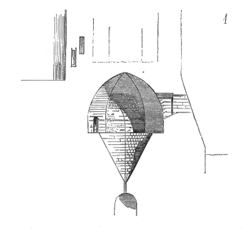This is an old revision of this page, as edited by Ryanjunk (talk | contribs) at 13:49, 19 May 2009 (rv unexplained and unsourced edits; please join us on the talk page to discuss reinserting trivia or popular culture references). The present address (URL) is a permanent link to this revision, which may differ significantly from the current revision.
Revision as of 13:49, 19 May 2009 by Ryanjunk (talk | contribs) (rv unexplained and unsourced edits; please join us on the talk page to discuss reinserting trivia or popular culture references)(diff) ← Previous revision | Latest revision (diff) | Newer revision → (diff) For other uses, see Oubliette (disambiguation).| This article needs additional citations for verification. Please help improve this article by adding citations to reliable sources. Unsourced material may be challenged and removed. Find sources: "Oubliette" – news · newspapers · books · scholar · JSTOR (July 2008) (Learn how and when to remove this message) |

Dictionary of French Architecture from 11th to 16th Century (1854–1868), by Eugène Viollet-le-Duc.
An oubliette (from the French oubliettes - plural noun, literally "forgotten places") was a form of dungeon which was accessible only from a hatch in a high ceiling.
History
To exit an oubliette was nearly impossible without outside help. The word comes from the same root as the French oublier, "to forget," as it was used for those prisoners the captors wished to forget. Most prisoners were left to die of starvation.
Another form of oubliette was a shelf in a long steeply sloping tunnel leading down to the moat or to the sea. Once cast down the tunnel, a victim would either slowly starve or cast themselves further down to drown.
The earliest use of the word in French dates back to 1374, but its earliest adoption in English is Walter Scott's Ivanhoe in 1819: 'The place was utterly dark—the oubliette, as I suppose, of their accursed convent.' (Oxford English Dictionary) There is no reason to suspect that this particular place of incarceration was more than a flight of romantic elaboration on existing unpleasant places of confinement during the Gothic Revival period.
At Leap Castle in Ireland workers discovered an oubliette. There are spikes at the bottom of this shaft, and when workers were cleaning it out, it took them three cartloads to carry out all the human bones at the bottom. A report indicates that these workmen also found a pocketwatch dated to the 1840s amongst the bones. There are no indications of whether or not the oubliette was still in use in that period.
There is an excellent example of an oubliette at the chateau in Meung-sur-Loire near Orleans in France. This consists of a submerged structure close to the castle. There is an opening at the top which reveals a large circular stone-clad pit, approximately twenty metres in depth, approximately five metres across, with sheer walls. It has a central hole in the floor, a pit within the pit, the lower pit being used for excrement and dead prisoners.
One example of what might be popularly termed an "oubliette" is the particularly claustrophobic cell in the prison of Warwick Castle, in central England. The access hatch consists of an iron grille secured by a hasp and (now) padlock.
Other meanings
Oubliette is also used to refer to ice formations over lakes or other large bodies of water. As ice crystals formed, and air was introduced in the movement of the tides, tunnels would form under the ice.
In literature
Oubliettes were a favourite topic of 19th century gothic novels or historical novels, where they appeared as symbols of hidden cruelty and tyrannical power, the very antithesis of Enlightenment values such as justice and freedom. Usually found under medieval castles or abbeys, they were used by villainous characters, often Catholic monks and inquisitors, to persecute blameless characters. In Alexandre Dumas's La Reine Margot, Catherine de Medici is portrayed gloating over a victim in the oubliettes of the Louvre.
An oubliette also features in Dornford Yates book "Blind Corner", a Chandos book.
An oubliette of sorts is featured in Cat's Cradle by Kurt Vonnegut, Jr. Though described as a dungeon and associated with other forms of torture, it is outfitted with some life-saving devices and serves as a severe-weather shelter following the introduction of ice-nine into the ocean surrounding San Lorenzo. The novel's narrator laments that "the creature comforts of the dungeon did nothing to mitigate the basic fact of oubliation."
See also
Footnotes
- La Reine Margot, XIII Oreste et Pylade
- Cat's Cradle, p. 264, New York: Dial Press, 2006.